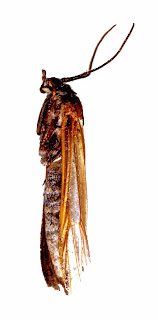ヒトリガ(Grammia behrii)Tiger Moth
- 052617 znp ut 赤い毛虫二匹。ハイキングトレイルをかなり早いペースで横断、川辺に自生する木の周辺の枯葉の近くでジッとしているものなど複数目撃。こんなに動き回っているのはもう餌を食べないのだろうと判断し蝶の蛹の入っているネットケージに移したが、内一匹がキベリタテハの蛹を食べてしまった。アクシデントでプラケースから逃げ出したが、室内で回収。もう一匹のほうは何も食べずに蛹化。
- 062717 mdr 成虫。プラケース内に採集ポイントの砂地をつめて幼虫を放置していたところ、数週間前に奇妙な形で蛹化。一匹は砂地の中に、もう一匹は地表でそのまま蛹化したのだが、体半分には幼虫の毛がついたままで、あとの半分は脱毛したかのようにつるっとした状態。
- オレンジの切れ端に近づいている気配すらない。
- 頭部も明瞭な写真撮影に再挑戦すること。
- 羽化後の蛹の破片も撮影すること。
- 火取蛾、燈取蛾、灯取蛾、火盗蛾、灯盗蛾。
http://bugguide.net/node/view/580238/bgimage
http://www.insects.jp/konbunringa13.htm
https://ja.wikipedia.org/wiki/ヒトリガ
http://www.jpmoth.org/Arctiidae/Arctiinae/Grammia.html
http://pnwmoths.biol.wwu.edu/photographic-plates/100/
http://bugguide.net/node/view/39181
http://mushi-sha.life.coocan.jp/hitoriga-zusetsu.html



























